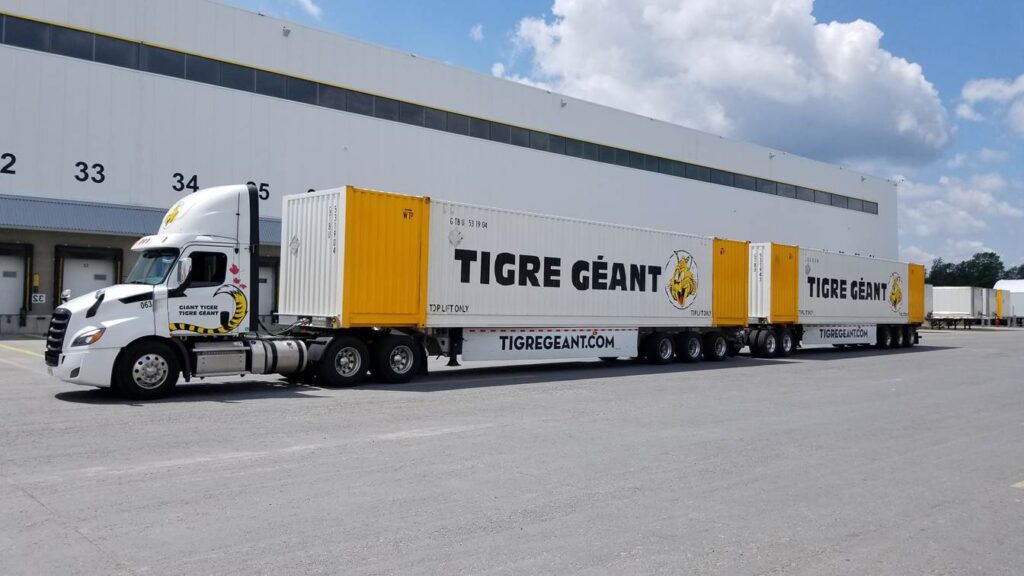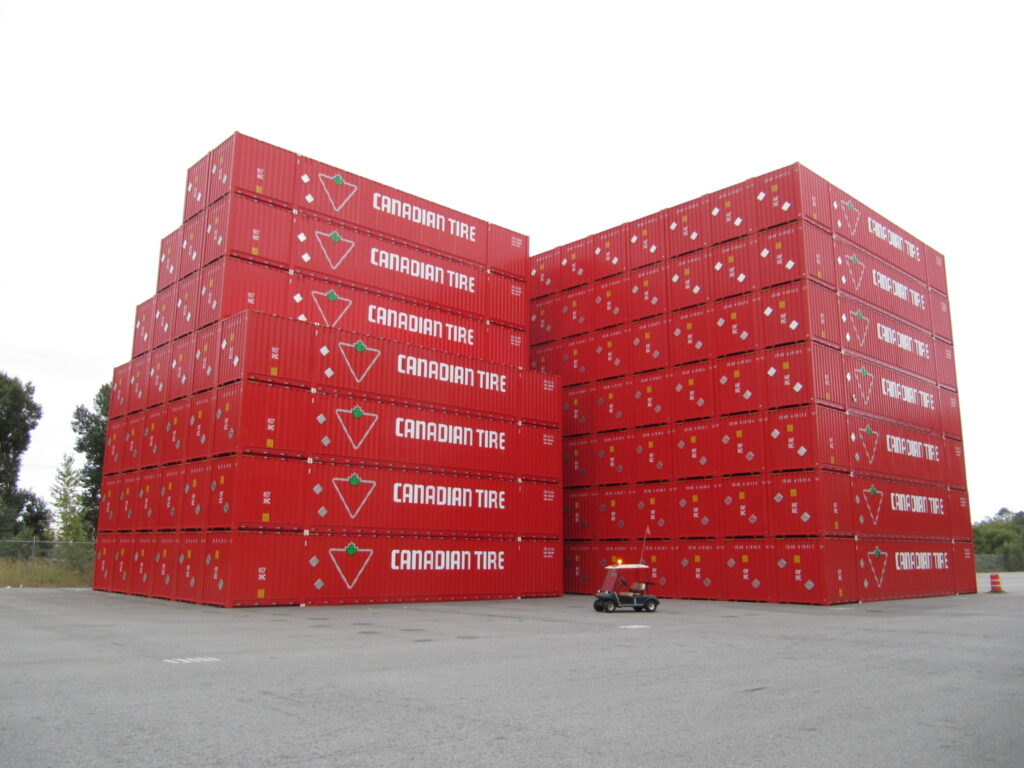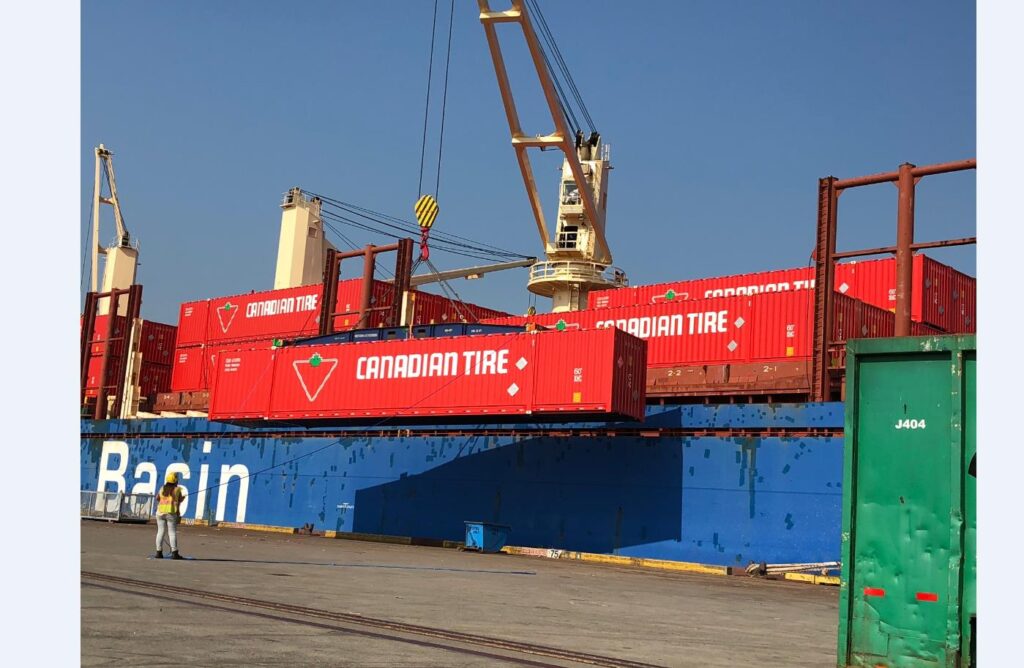Canadian retailers packing larger containers in pursuit of productivity
Giant Tiger, a Canadian-headquartered discount retailer, is expanding the productivity of its truck fleet by expanding the size of equipment itself.
The fleet already incorporates long combination vehicles (LCVs) in its operation, but is now making further investments in 53-foot intermodal containers.
The longer units boast 60% more capacity than a standard-height 40-foot container, offering a perfect match for the fleet that often cubes out before maximizing allowable gross vehicle weights.
“We cube out way before we weigh out,” says James Johnstone, associate vice-president – transportation, referring to cargo that includes fashion items, towels, pillows and stuffed animals.
It handles the 53-foot containers through a transload facility in Vancouver. From there a team cycles them to Montreal. Goods destined for Brampton, Ont., may even move by LCV.
All of the chassis are spec’d with fuel-savings in mind, which means using aerodynamic skirts, along with aluminum wheels, super-single tires, and disc brakes. “Everything we could to cut weight down,” he said.

The boxes themselves are closer to a U.S. spec’, because they’re essentially dead weight when empty.
Galvanized components are also used in the name of fighting corrosion.
Using fixed 53-foot units, rather than extendable versions, means there’s no slider to worry about greasing or failing, he said. “It allows us to to add a skirt on a spring-loaded arm.”
The 53-foot containers are moved through an intermodal service from Vancouver to Brampton, realizing “massive savings.” The containers can also be grounded, while for-hire carriers would be anxious to turn the assets.
“We’re a low-cost operator. We have a fiduciary duty to our company and our customers to keep our prices as low as possible.”
James Johnstone, Giant Tiger
The retailer realizes plenty of benefits through its choice of a private fleet rather than outsourcing transportation to a for-hire operation, he says.
The in-house operation helps to control costs and the business density, because it’s less exposed to rate increases. “We’re a low-cost operator. We have a fiduciary duty to our company and our customers to keep our prices as low as possible,” Johnstone says.
“The approach we’re taking is it’s basically a modular trailer,” Johnstone says. “We’re really big on rolling this traffic through our LCV program.”
The fleet gains 13% capacity in the container.
Giant Tiger already has 50 units in service, but others are coming.
“We have a really good transload partner in Vancouver (Triumph). They do a fantastic job with filling that void space,” he says, referring to the target of ensuring 90% is filled.
“What makes the relationship great is they understand our business. They’re very in tune with our volumes. They’re very in tune with our terms, processes and procedures.” They also communicate every day. “It’s absolutely seamless. It’s as if they’re an extension of our existing team.”
Finding the equipment is no small task. There are a limited number of companies in the world that manufacture intermodal containers, and most of that comes from China. Giant Tiger found its supplier by reaching out to industry peers.
“The most important thing is we didn’t try to create something that would appease all the buckets. It was something that was really unique to our requirements.”
Loads weighing in at 30,000 to 35,000 lb. would be considered heavy, but there are provisions for heavier weights.
One of the reasons is that some loads are picked up in Quebec during spring thaws, when weights can be limited on specific routes.
“The only challenges are getting them into the port, and it’s a mad dash getting everything off the ship,” he said. Luckily, because of the limitations when it comes to shipping 53-foot containers, they have to arrive on smaller vessels, and are lashed to the decks and pulled off with cranes. In contrast, 40-foot containers are moved about with massive gantry cranes.
The chassis are made by Mississauga-based ITD, which place the skirts and graphics on the units, and they’re leased through an agreement with Trailcon Leasing.
First to 53, then to 60
Another Canadian retail giant, Canadian Tire, was the first company to deploy 53-foot containers, and has since begun using 60-footers.
“We have built the largest private fleet in Canada, with over 7,000 units in operation,” Gary Fast, vice-president of transportation with Canadian Tire, said of 53-ft. containers.

It has taken its supersized containers to the next level, becoming the first “anywhere” to use a 60-foot intermodal container. Canadian Tire now has 153 60-ft. units in operation, and plans to grow the fleet to 600 by the end of 2021. In total, Canadian Tire is in the process of adding another 1,000 containers to its fleet, a combination of 53- and 60-ft. units.
Canadian Tire also sources its container chassis from ITD, and also from Montreal-based MaxAtlas. The containers themselves are manufactured in China but to a Canadian spec’.
While Canadian Tire deployed 53-ft. containers in LCV configurations over the road, Fast noted “not all roads are practical for this application.”
Still, the 53-ft. container has been Canadian Tire’s standard spec’, and “poses few challenges with only a handful of retail locations unable to accommodate deliveries from these units,” Fast said.
The container chassis spec’d by Canadian Tire are primarily extendable from 40- to 53-ft., or 40- to 60-ft. in length. The most recent chassis are spec’d with roll stability for LCV operations, and the retailer spec’s 100% hot galvanized chassis for corrosion resistance rather than painted steel.

The containers themselves are shot blasted and a zinc shop primer is used to resist corrosion.
“Additionally, moving and external parts such as the hinge, handles, locks and all fasteners have additional galvanization and zinc plating spec’s,” said Fast. “We line our container walls with plywood and install E-F track to make it easier for our distribution center teams to secure loads.”
Have your say
This is a moderated forum. Comments will no longer be published unless they are accompanied by a first and last name and a verifiable email address. (Today's Trucking will not publish or share the email address.) Profane language and content deemed to be libelous, racist, or threatening in nature will not be published under any circumstances.